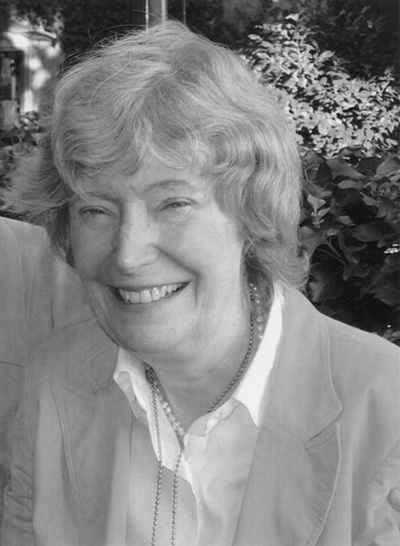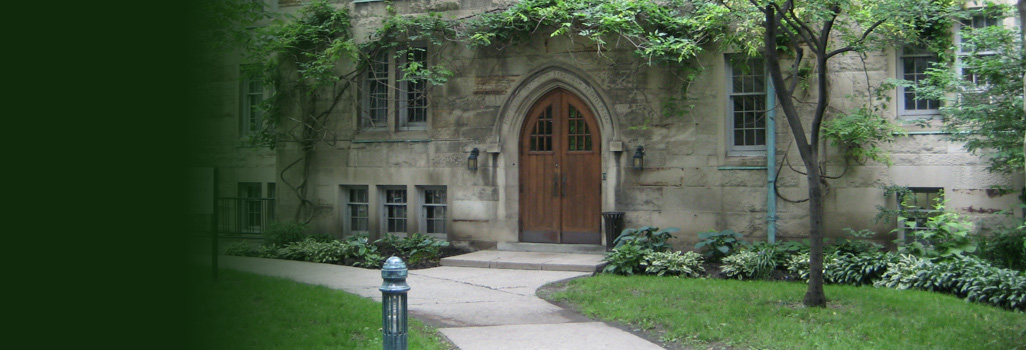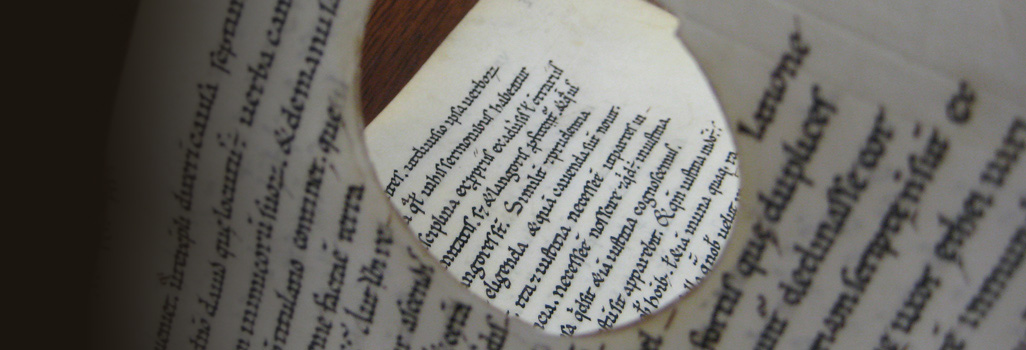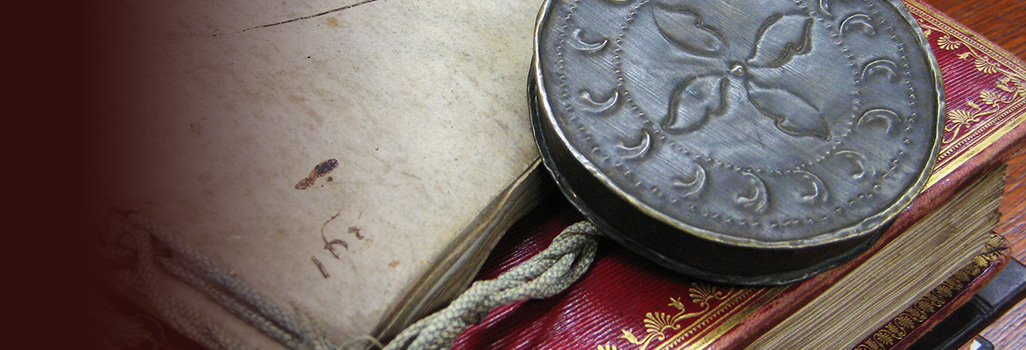
Virginia Brown (1940–2009)
Senior Fellow, Pontifical Institute of Mediaeval Studies
In memoriam
Virginia Brown, Senior Fellow Emerita, died peacefully on 4 July, Independence Day, in her home in Cambridge, Massachusetts, of complications of pancreatic cancer. She was buried on the feast day of St. Benedict, 11 July, in Valley Forge, Pennsylvania. In her early years at the Pontifical Institute she preferred that students and even some faculty address her as Miss Brown—a holdover from her experiences as a graduate student at Harvard. But this gradually broke down and she was glad to be addressed as Virginia or Ginny, as her close friends knew her.
Ginny was born on 11 October 1940 and grew up in the small town of Lake Providence, Louisiana, near the Arkansas border. Her father was a businessman and editor of the local paper and her mother was a Latin teacher, making her later careers as an editor and Latinist almost predictable. She received her early education in a one-room Catholic school house and then went to the Academy of the Sacred Heart, the Rosary, in New Orleans, where she was the first female to win the all-city Latin prize. On graduating from high school she entered the Manhattanville College of the Sacred Heart in New York, majoring in Latin literature. Her outstanding performance there led to her acceptance as a graduate student at the University of North Carolina at Chapel Hill, where she studied with the renowned classicist Berthe Marti. Rather than continuing her studies there after receiving her M.A., Ginny was accepted as a Ph.D. student in Harvard’s Classics Department. There she studied with Wendell Clausen, a distinguished scholar of Latin poetry, text editor, and palaeographer. At his urging and that of Berthe Marti she applied for and won the “Rome Prize” for study at the American Academy in Rome (1966–68). During this time she worked on her doctoral thesis, for which she received her Ph.D. at Harvard in 1969. In her second year in Rome she became the first woman to win a diploma in advanced archival and palaeographical studies at the Scuola Vaticana di diplomatica e paleografia at the Biblioteca Apostolica Vaticana. Also in her second year of study she again met Marti, who advised her that the legendary palaeographer, E. A. Lowe of Princeton’s Institute for Advanced Study, was looking for an assistant, especially to help him complete his monumental multi-volume Codices latini antiquiores. She applied for the position and worked on this and Lowe’s papers from 1968–70.
At Princeton she met Paul Oskar Kristeller of Columbia University, whose monumental work, Iter Italicum, was the result of countless journeys to libraries and archives to ferret out manuscripts of classical authors and Renaissance humanists. Kristeller was then the editor-in-chief of the Catalogus translationum et commentariorum and persuaded Ginny to write a section on the transmission of the works of Julius Caesar, the subject of her doctoral thesis. She also met Fr. J. Reginald O’Donnell, C.S.B., of the Pontifical Institute, who was at that time a visiting Member of Princeton’s Institute. Ginny fondly recalled that beyond their discussions of Latin and medieval authors she acted as his “assistant” in fetching him cornflakes and scotch for his breakfasts. Fr. O’Donnell asked her if she would come to Toronto as his successor, and in 1970 she became the first lay female Fellow of the Pontifical Institute—thereby forcing it, she said, to install restrooms for women.
Beginning a distinguished teaching career at the Institute, she took up Fr. O’Donnell’s text editing course using as a tool the Sapientiale of Thomas of York, for which Fr. O’Donnell had received a grant to edit in the 50s. To avoid the rigors of this mandatory course some students chose to take the alternate mandatory course in diplomatics taught by Fr. Leonard Boyle, where they were allowed to edit texts other than the Sapientiale. Those who dared enroll in Ginny’s seminar were terrified, but she patiently and gently shepherded them through the manuscripts and sources of this difficult text, which they later would say was their most valuable educational experience at the Institute. There remains a small band of distinguished professors in North America who pride themselves as “Survivors of Thomas of York.”
A turning point in her teaching career came when she was nudged to forsake her beloved Thomas of York and move into the enormously popular palaeography seminar that had been taught for many years by Fr. Boyle, before he left to become Prefect of the Vatican Library in 1984, and subsequently by James Reilly and Jennifer Morrish. Ginny was reluctant, but it was emphasized to her that she had, after all, been instrumental in the publication of Lowe’s Codices latini antiquiores, had cooperated with Bernhard Bischoff in the “Addenda to Codices latini antiquiores” published in Mediaeval Studies, was recognized internationally as the foremost expert in the Beneventan script, and had been elected to the elite Comité international de paléographie latine. Arrangements were thus made for John Magee to come to the Institute to teach text editing, and Ginny took over the palaeography seminar. She succeeded beyond measure, and for this she won the admiration and love of countless students and was given the prestigious distinguished teacher award by the Medieval Academy of America in 2005. Just before her death many of these students honored her with a moving collection of reminiscences and tributes. Beyond her work in the classroom, she was a valued member of thesis boards and was constantly called upon to advise and sit on masters, licentiate, and doctoral boards because of her expertise in Latin and text editing.
Ginny was an editor without equal and until the end of her life generously edited and improved the work of other scholars. She was a stickler for details, and her curiosity was beyond bounds. The margins of every typescript she returned to authors were filled with suggestions and requests for expansions and more detail. Her work as an editor was in at least four major areas. First, in 1974 she became Fr. O’Donnell’s successor as the editor of the Institute’s journal Mediaeval Studies, a post she held until 1988. As the sole editor she was charged with the annual publication of a volume amounting to as much as 673 printed pages. This involved yearly appraisal of as many as 140 submissions, correspondence (at times up to 1500 letters), copyediting, and proofreading. The current editor has calculated that the fourteen large volumes she edited contain about a quarter of the articles in all seventy volumes published to date and almost 35% of the texts edited in them. When she retired from the post, her position was temporarily assumed by Walter Principe, Steven Dumont, her former assistant Edward English, and me, something that amused her greatly. “It took four men to do the job of one woman,” she would laugh.
Her second important editorial position was with the Catalogus translationum et commentariorum. She became a member of the editorial board in 1977 and advanced to secretary and editor-in-chief by 1985. Her vast learning as a classicist, medievalist, and Renaissance specialist was critical in that position, and she was not only a co-editor of volumes 6–9 of the series but also the author of a number of entries in other volumes.
A third editorial position, one at Harvard, was both “honorary” and official. In 1983 she astonished her colleagues at the Institute by announcing her marriage to James Hankins, then completing his doctoral studies at Columbia University under Paul Oskar Kristeller. Their happy marriage began with a celebration of what she called “mutual Wissenschaft”—a honeymoon morning after a flight to Paris consulting a manuscript dealer there and working at the Bibliothèque Nationale. Their lives thereafter—commuting between Toronto and Harvard—were filled with love and scholarship in which each helped the other. Her “official” editorial position came with the founding by her husband of the Harvard I Tatti Renaissance series published by Harvard University Press. Ginny herself produced two volumes, the most notable being the first in the series, an edition and translation of Boccaccio’s Famous Women. This was an instant sensation, selling out in two months, going into paperback and translation in many languages, including oriental languages, and being adopted in women’s study courses throughout America.
A fourth editorial position was largely a hidden one. Each summer as we worked in the archive at Montecassino, don Faustino Avagliano, the archivist and prior of the Abbey, would bombard her with proofs of scholarly volumes he was publishing for the Abbey, asking for her editorial assistance. It was, she laughed, a “payback” for the American military aerial bombardment of the Abbey during World War II. Each summer she would spend hours with these proofs, forfeiting time from her own research. Even into the final months of her life she devoted her last precious remaining time to editing a new translation of don Tommaso Leccisotti’s history of Montecassino.
In her editorial work and her own scholarship Ginny was always quick to take advantage of new technologies. When she arrived at the Institute she was legendary for her speed and accuracy on her electric typewriter. But as computers were being introduced she was one of the first fellows of the Institute to use them—and to urge her colleagues to follow suit. When she saw me under intense pressure to complete four lectures for two major conferences, she forced me into her chair and said, “You will write these on my computer,” which I did, and in a timely fashion. The Institute has always been known for its early microfilming of European manuscripts, thereby preserving a number lost in World War II. Ginny continued this tradition building up at her own expense a large collection of microfilms of classical, Renaissance, and especially Beneventan texts, preserving items lost during the recent conflicts in Croatia. As one of the world’s experts in deciphering medieval palimpsests, she continuously used ultraviolet technology and on her research journeys carried her own machine. On her computer she was then able to manipulate both the ultraviolet photos of palimpsests and those she took herself.
Over her years as a Fellow of the Pontifical Institute she spent countless hours in administrative work. Early on she was an important member of the Latin Committee of the University’s Centre for Medieval Studies. With her wide contacts in the classical and medieval worlds of scholarship she was of incomparable value to the Publications Committee of the Institute in its search for appraisers and readers of typescripts submitted to it, and she was also instrumental in the rejuvenation of the Institute’s publications program. Ginny was an ardent supporter of the Institute’s Library, seeing to it that appropriate volumes on palaeography, text editing, and classical literature were ordered and giving hundreds of her own to enhance the Library’s holdings, and she was passionate about protecting the Institute’s large microfilm collection and maintaining a good relationship with the manuscript depositories from which the films had been obtained. In Institute policies and decisions of the Fellows she always argued for upholding the highest standards and would even fly back to Toronto from Europe at her own expense to cast a critical vote.
She was a member of many academic and learned societies, a distinguished visiting fellow of several universities, and the winner of numerous awards. Among the academic societies and boards she served were ones in classical, medieval, and Renaissance studies, ranging from Italy, France, and the United Kingdom to the United States and Canada. She was a Distinguished Visiting Fellow at St. Hilda’s College, Oxford, the University of California at Los Angeles, the Centro Universitario Europeo per i Beni Culturali, Ravello-Montecassino-Rome, and the Università degli Studi ‘Ca’ Foscari’ di Venezia. Over the years she was elected to many honorary memberships, including a Corresponding Member of the Zentraldirektion, Monumenta Germaniae Historica (1998), Corresponding Member of the Deputazione Abruzzese di Storia Patria (2001), Member of the Comité d’honneur, Cinquantenaire de l’Institut de Recherche et d’histoire des textes, Paris (1987), Member of the Arbeo-Gesellschaft, Munich (1989), and Member and Correspondent of the Accademia degli Agghiacciati, Sulmona, Italy (1991). Among her distinguished lectureships were the Lowe Lectures in Palaeography, Corpus Christi College, Oxford (2004–2005), and the Daly Lectures at St. Louis University (2008). Throughout her career as student, editor of Mediaeval Studies, and professor she was awarded numerous grants and fellowships, including a Guggenheim Fellowship, a Mellon Foundation Award, and a Killam Research Award from the University of Toronto.
Her major scholarly passion was the Beneventan script, and she was legendary for her frequent question of anyone she encountered, “You will let me know, won’t you, if you come across any Beneventan manuscripts?” Early in my career at the Pontifical Institute in the late 70s she came to me with that question and a large stack of reproductions of manuscripts and fragments written in Beneventan. During the previous years a number of eminent palaeographers, including Augusto Campana, Guglielmo Cavallo, and Julian Brown, had asked her to revise and enlarge E. A. Lowe’s classic The Beneventan Script published in 1914. Many of the items he described in that volume and in his later “New List” (a title Ginny often reused later) were registered simply as “liturgica” or “collectio canonum,” and Ginny, always a stickler for precision, pressed me for more exact descriptions. The canon law items were easy, but the “liturgica” were more challenging. As I worked on these I involved a number of my liturgy seminar graduate students, among them Richard Gyug, and we completed the task of identification for Ginny. Beyond this, two major general conclusions came out of my work on her Beneventana: first, an astonishing 70% of all manuscripts in Beneventan were liturgical and, second, because they were liturgical and written in a beautiful, conservative style, they had been dated as much as two centuries too early by Lowe and others. All of this was the beginning of what would become our major project over the decades, the Monumenta liturgica beneventana, one that Richard Gyug and I will continue in Ginny’s memory.
Out of these early conclusions, I had proposed in 1981 a sabbatical research project, but for a single person to take on a project like this for only a year’s duration was questionable and, understandably, my proposal was not approved in Ottawa. Hence, after several years, I devised another program to take advantage of Ginny’s expertise in Beneventan script and mine in liturgy. It would be called the Monumenta liturgica beneventana, borrowing the name “Monumenta” from the Munich Monumenta germaniae historica, of which I had been a corresponding member of the Zentraldirektion. It would not be an individual project but a cooperative program, which the Social Sciences and Humanities Research Council of Canada was just then promoting. Ginny—as a woman who was the world’s leading authority on Beneventan script and likely to be well known to the classicists on the jury in the grants competitions—would be our Capo. Further, the adjudication procedures were being modified to favor past “track-records” (i.e., publications) over project proposals that might or might not produce publishable results, and abundant track-record we had and would continue to have.
One can read on the Institute’s website how the program has prospered and grown with the generous support of the SSHRC. Ginny was clearly our Capo. Her knowledge of the Beneventan script was unrivalled. Through her many contacts in Italy, her determination never to take “no” or “later” from a reluctant or lazy librarian or archivist, and her innate curiosity, we gained access to depositories that no one else had heard of; and the result is evident in the “New Lists” of hitherto unknown Beneventan items published in our series Miscellanea Beneventana, which as editor she had initiated in Mediaeval Studies. To the nearly 1,000 items that Lowe knew, another 2,000, the vast majority liturgical, have been added in the five lists. Then there was her “oculus paleographicus / paleographical eye,” as she put it, and incredible visual memory that makes a good palaeographer a truly great one. “Yes,” she would say as she examined a manuscript in Italy or Dalmatia, “there is another fragment of this manuscript I have seen in Stockholm or Vienna” or wherever. But most impressive to me was her development from a superb editor of classical texts into a first-rate liturgical scholar and historian. Her publications on Beneventan script liturgical calendars, missals, breviaries, and the like are admired and often cited by liturgical scholars around the world. Her brilliant redating through archival records of a number of liturgical manuscripts in Naples to the sixteenth century rather than the fourteenth as Lowe argued has fundamentally altered the dating of all Beneventan manuscripts, and her archival work on the Beneventan liturgical palimpsests written in Naples beneath the famous Boccaccio autographs now in Florence was a sensation among Renaissance historians, even resulting in a major international conference in Florence. Beyond that, she was a regular consultant to the auction firms of Sotheby’s, Bernard Quaritch, and Christie’s regarding manuscripts they intended to sell, the most notable being the full sixteenth-century Neapolitan prayerbook with Italian prayers in Beneventan that she and I bid on but lost to her friend Martin Schøyen, who had given her the only genuine fragment of Beneventana now in Canada. Ginny amassed at the Pontifical Institute, largely with her own funds, the largest collection in the world of reproductions of Beneventan script manuscripts, thus making the Pontifical Institute what Thomas Forrest Kelly of Harvard calls the “Beneventan capital of the world,” which scholars from North America and Europe would frequently visit to discover materials of interest to them. Her consultation with the British Government in repatriating a magnificent liturgical manuscript she discovered “removed” from Benevento to London after World War II by a British soldier resulted in her being made an honorary citizen of the city of Benevento in southern Italy. Finally it was Ginny who brought don Faustino Avagliano to the Pontifical Institute at her own expense to receive an honorary degree and who persuaded him to bring along a suitcase of the Abbey’s most precious manuscripts for an exhibition in the Institute—something never done before in the venerable Abbey’s history. Eventually don Faustino was to return the honor by holding a conference and gala reception at the Abbey to celebrate the appearance of her collected essays in Terra Sancti Benedicti. Studies in the Palaeography, History, and Liturgy of Medieval Southern Italy.
Beneath the brown cap pulled over her sensitive ears and the warm sweater wrapped around her was a soul devoted to her Church. She had been a Sacred Heart girl from her youth and so promptly at noon each Friday would excuse herself from our work to attend Mass, and each Saturday at 5 p.m. she would fulfill her Sunday Mass obligation so she could devote her entire Sunday to scholarship. Then there was her financial generosity to multiple worthy causes. She gave of what she had to many charities, institutions, and individuals that only God and her taxman know. One charity, however, was more visible. She was a champion of the Center for Epigraphical and Palaeographical Studies at the Ohio State University, whose director, Frank Coulson, had been one of her students in the text editing seminar, and her donations there resulted in what was named the Virginia Brown Visiting Fellowship program. To celebrate her generosity and her sixty-fifth birthday the Center sponsored a memorable conference in her honor, the results of which were published in Classica et Beneventana: Essays Presented to Virginia Brown on the Occasion of Her 65th Birthday.
As a person Ginny was charming, vivacious, and humorous, with a radiant smile reflecting a gladsome inner joy and with a girlish, stuttering voice bearing a southern lilt. Her kindness and friendship knew no bounds. On a very personal level, in the turbulent years of my life, Ginny was always there to help out and to give moral support or lend a sympathetic ear. Then there was her assistance (and that of Jim Hankins) in bringing my wife, Liubov Alexeevna, from Russia to Canada and the U.S.; I personally witnessed their winsome invitations work wonders at the feared visa window of the U.S. consulate in Moscow. Finally, there was her friendship in southern Italy and Dalmatia as we worked each summer on our Beneventan project for over two decades—the laughter and stories about the events of the day, daily drives up and down the 8.73 km winding road to the Abbey on Montecassino or along the spectacular Dalmatian coast, navigating back roads to obscure depositories that might yield precious Beneventana, visits to historical, ecclesiastical, and monastic sites, shopping at local markets, and the list goes on.
For nearly forty years as a Fellow of the Institute Ginny witnessed it at its zenith, with a large staff of major philosophers, theologians, historians, canonists, liturgiologists, palaeographers, archaeologists, Byzantinists, Slavicists, and specialists in Latin and vernacular literatures, and a vibrant pontifical licentiate and doctoral academic program producing talented young medievalists with multidisciplinary skills, in addition to a library that had become the envy of medievalists around the world and a publications department issuing a torrent of books and a journal at the highest level of scholarship. She also witnessed and lamented the Institute in decline as its staff was reduced and it was forced through economic pressure to suppress its historic pre-doctoral licentiate program, but through all of this she was fiercely loyal to the Institute and sought with all her might to maintain its traditional high standards and reputation. “Frail Little Ginny Brown,” as she used to call herself, was slight of physical stature but a giant as a scholar, a colossus as an Institute colleague, and a steady and firm bedrock as a friend to those both inside and outside the Pontifical Institute.
ROGER E. REYNOLDS
Pontifical Institute of Mediaeval Studies
Bibliography
Please click here to see a bibliography of Virginia Brown's works.
Source
This memorial notice and bibliography originally appeared in Mediaeval Studies 71 (2009): vii–xx. © Pontifical Institute of Mediaeval Studies.


